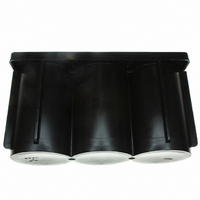0809-0012 EnerSys, 0809-0012 Datasheet - Page 9

0809-0012
Manufacturer Part Number
0809-0012
Description
BATT CYCLON SLA 6V 5.0AH
Manufacturer
EnerSys
Series
Cyclon®r
Type
Sealed Lead Acid Batteriesr
Specifications of 0809-0012
Voltage - Rated
6V
Capacity
5.0Ah
Size / Dimension
5.48" Dia x 2.12" H (139.2mm x 53.8mm)
Termination Style
Spade, .250" (6.3mm)
Rechargeability
Yes
Weight
2.2 lbs (997.9g)
Output Voltage
6 V
Chemistry
Lead Acid
Rechargeable/non-rechargeable
Rechargeable
Battery Capacity
5 Ah
Battery Voltage
6V
Battery Technology
Pure Lead
External Height
76.7mm
External Width
53.8mm
External Depth
139.2mm
Battery Terminals
Tab
Height
3.02"
Rohs Compliant
NA
Lead Free Status / RoHS Status
Lead free by exemption / RoHS compliant by exemption
Other names
842-1010
Available stocks
Company
Part Number
Manufacturer
Quantity
Price
Company:
Part Number:
0809-0012
Manufacturer:
RENATA
Quantity:
4 000
The movement of oxygen from the positive electrode to the
negative electrode is facilitated by the use of highly porous
separators that allow the oxygen to diffuse within the cell
and cause the reaction defined by Equation 1. The acidic
conditions prevailing inside the cell is very conducive to the
reaction between lead oxide and the sulfuric acid to form
lead sulfate in accordance with Equation 2 below:
As the lead sulfate is deposited on a surface that generates
hydrogen, it (lead sulfate) is reduced to lead and sulfuric
acid as indicated by Equation 3:
Adding the three equations and canceling out like terms on
either side of the equations, we obtain Equation 4:
These four equations show the reactions that form
the principle of recombination that is employed by the
CYCLON
the cell, recombination efficiencies in excess of 99%
are achieved in the CYCLON batteries.
3.6 Shock & Vibration Characteristics
The spirally wound plate element is compressed within a
polypropylene liner or case, minimizing plate movement
in high shock or vibration applications. Movement in a
vertical direction is also limited by the polypropylene lid
design. Overall, the cell has excellent shock and vibration
characteristics.
3.7 Float Life Characteristics
As noted previously, life expectancy of CYCLON batteries
is not limited by loss of electrolyte due to the sealed
design. Instead, life expectancy is determined by
long-term corrosion of the positive current collecting grid.
The corrosion effect on cell capacity is minimal until the cell
approaches end-of-life, which is defined as the inability of
the cell to provide at least 80% of its rated capacity.
3.8 Cycle Life Characteristics
The cycle life of the cell in an application will be a function
of the depth of discharge (DOD), temperature and charging
rate. Depending on the DOD, the cycle life available can vary
from 300 to more than 2,000. However, to get these cycle
numbers, the battery must be recharged effectively.
1
hours at the 10 hr rate of discharge. Thus the 2C
www.enersys.com
The C
10
rate of a battery is defined as the charge or discharge current in amperes that is numerically equal to the rated capacity of a cell in ampere-
®
2PbO + 2H
2PbSO
2H
battery product line. By properly designing
2
+ O
4
2
+ 2H
➔ 2H
2
SO4 ➔ 2PbSO
2
➔ 2Pb + 2H
2
O (Eqn. 4)
4
2
SO
+ 2H
10
4
rate for a 5Ah cell would be 10 amps.
2
O (Eqn. 2)
(Eqn. 3)
3.9 Fast Charging Characteristics
Efficient fast charging can be accomplished using a
constant voltage charger. With an initial charge current
capability in the 2C
to better than 95% state of charge in less than one hour.
Applications using fast charging must allow for periodic
extended charging to maximize life.
3.10 Storage Characteristics
The CYCLON battery cell and monobloc may be stored
for up to two years at room temperature (25°C or 77°F)
and recharged with no loss in cell reliability or performance
capabilities. The recharge may be accomplished without
resorting to special charging techniques.
When batteries are stored at or near 25°C (77°F) we
recommend conducting an OCV audit every six (6) months
and recharging when OCV readings approach 2.00 volts
per cell (VPC). If storage temperatures are significantly
higher than 25°C (77°F), even for short durations, the
frequency of OCV audits must be increased.
4.1 Introduction
Discharge tables and curves for CYCLON batteries are
shown in Appendix A. The capacity available from a cell is
a complex function of the state of charge, temperature, the
rate of discharge and the end of discharge voltage (EODV).
The tables provide the discharge performance of these cells
to various EODVs. The graphs provide the same information
but only to three EODVs.
4.2 Discharge Voltage Profile
Figures 4-1 and 4-2 show the room temperature (25°C/77°F)
voltage profile of CYCLON battery cells when subjected to
four loads - C
In all cases, the low internal resistance of the cells allows
very stable voltage profiles, regardless of whether the
discharge is moderate (C
(1C
10
Chapter 4:
Discharging CYCLON
to 2.2C
10
10
).
/10, C
10 1
10
Publication No: US-CYC-AM-007 - April 2008
range the cell can be recharged
/5, 1C
10
/5 to C
10
and 2.2C
®
10
Batteries
/10) or at a high rate
10
.
9



















